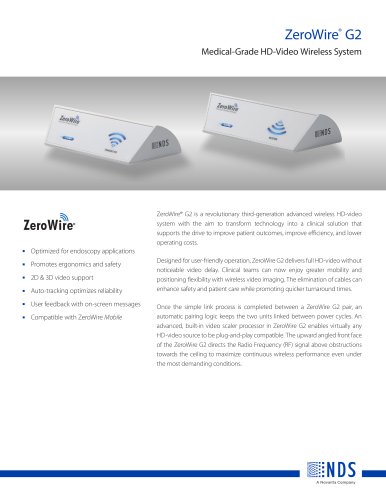
Catalog excerpts

ACR Guidelines Explained Peter M. Steven, Ph.D. November 2011 The goal of the ACR Technical Standard for Electronic Practice of Medical Imaging is to facilitate a standard for the evaluation of digital diagnostic systems. In the preamble to the ACR Standard, the authors state: The ultimate judgment regarding the propriety of any specific procedure or course of action must be made by the physician or medical physicist in light of all the circumstances presented. Thus, an approach that differs from the standards, standing alone, does not necessarily imply that the approach was below the standard of care. To the contrary, a conscientious practitioner may responsibly adopt a course of action different from that set forth in the standards when, in the reasonable judgment of the practitioner, such course of action is indicated by the condition of the patient, limitations of available resources, or advances in knowledge or technology subsequent to publication of the standards. However, a practitioner who employs an approach substantially different from these standards is advised to document in the patient record information sufficient to explain the approach taken. The ACR is setting clear, measurable parameters to aid in diagnostic system assessment. Our focus will be the display system and its assessment (Section IV-D), but it is important to remember that the ACR was seeking to address the entire diagnostic imaging chain, from acquisition and storage to display and diagnosis. Ultimately, it is the practitioners of diagnostic radiology who have, by their collective actions, set the standard of care. Resolution and Visualization As diagnostic radiology moved from film to computer screens, the ACR sought to set standards to assure that clinically valuable information be clearly represented on the new viewing technology. The visualization of images cannot be compromised. Acquisition, storage, and display are all key components in that imaging chain. Section IV-D part 1 deals with the general characteristics of a display and image-viewing software. The standard was written when CRT displays were still in common use, so in setting minimum standards for contrast and brightness, the ACR was mindful of CRT limitations. Hence the minimum brightness standard was 170 cd/m2. Current LCD-based displays offer significantly more brightness than their CRT predecessors. Other base characteristics are also easily achieved, though it is worth noting that several of them pertain to the PACS software, and are not truly characteristics of the display hardware.
Open the catalog to page 1
Section IV-D part 2 deals with low-resolution images, while part 3 addresses high-resolution images. Here we need to carefully define resolution. In acquisition, resolution means the resolving power of your acquisition system. For the ACR, the acquisition of large-matrix images (anything previously acquired on film) must be imaged to 2.5 lp/mm resolution in the original detector plate (see Section IV-A). In the display, resolution refers to the size of the pixel matrix. Thus, 3MP resolution refers to the three million pixels typically in a 1536 x 2048 pixel matrix. The two uses of the term...
Open the catalog to page 2
Display Characteristics The ACR is recommending higher resolution displays for 14” x 17” films because of the acquisition resolution at 2.5 lp/mm, not a display resolution of 2.5 lp/mm. The pixels on the Dome 3MP grayscale displays are 206 microns and 211 microns on color displays. The difference arises because the 3MP gray LCD at 20.8” diagonal is slightly smaller than the 3MP color LCD at 21.3”. If you continue this logic, shrinking the display to 20.2” would make the pixels smaller than 200 micron, but surely this does not make the display more appropriate for chest film viewing. This is...
Open the catalog to page 3
hospitals use 3MP displays for general radiology, including chest film reads. The data loss is seen as not clinically significant. Another area where the ACR states an unambiguous opinion is a few paragraphs after the discussion of resolution and display size. Section IV-D, part 5, item a.iii states “Protective shields on LCDs add to reflections and should not be used if possible.” This references the ACR’s clear concern about reflected light, particularly specular reflections that come off flat glass surfaces. If the ACR guidelines are the absolute standard by which displays are selected,...
Open the catalog to page 4All NDS Surgical Imaging catalogs and technical brochures
-
ZeroWire® G2
2 Pages
-
EndoVue® 32”
2 Pages
-
EndoVue® 21”
2 Pages
-
EndoVue®24”
2 Pages
-
RADIANCE® ULTRA 27”
2 Pages
-
Endoscopy Solutions Catalog
48 Pages
-
DOME S3c LED
2 Pages
-
Dome Dashboard
2 Pages
-
ZEROWIRE ULTRA
2 Pages
-
Radiance Ultra
2 Pages
-
LIFEVUE SERIES
2 Pages
-
Dome E5
2 Pages
-
Dome GX2MP Plus
2 Pages
-
Dome E3c High-Bright
2 Pages
-
Dome S6c LED
2 Pages
-
32" RADIANCE ® FULL MMI?
1 Pages
-
55" RADIANCE ® G2
2 Pages
-
26? RADIANCE ® G2 HB
2 Pages
-
24? RADIANCE ® G2
2 Pages
-
Dome E2 Grayscale Display
2 Pages
-
Dome E3
2 Pages
-
Dome S10 Grayscale Display
2 Pages
-
Dome S3
2 Pages
-
Dome GX4MP
2 Pages
-
Simple Monitor Math
1 Pages
-
Zerowire Wireless Imaging
1 Pages
-
ScaleOR Video Informatics
1 Pages
-
ConductOR Video Informatics
1 Pages
-
Radiance with Touch
1 Pages
-
Radiance G2 HB Display
1 Pages
-
Radiance With Full MMI
1 Pages
Archived catalogs
-
Dome Dashboard
2 Pages






































